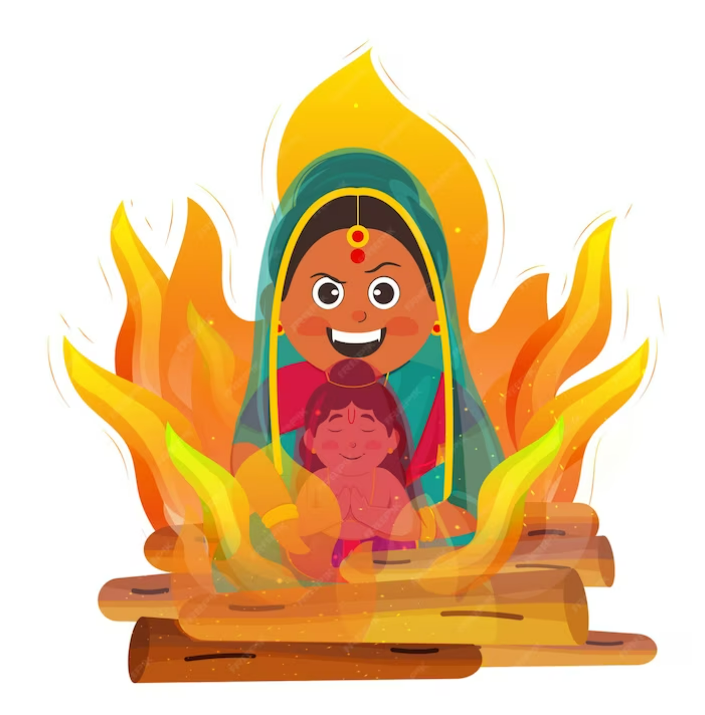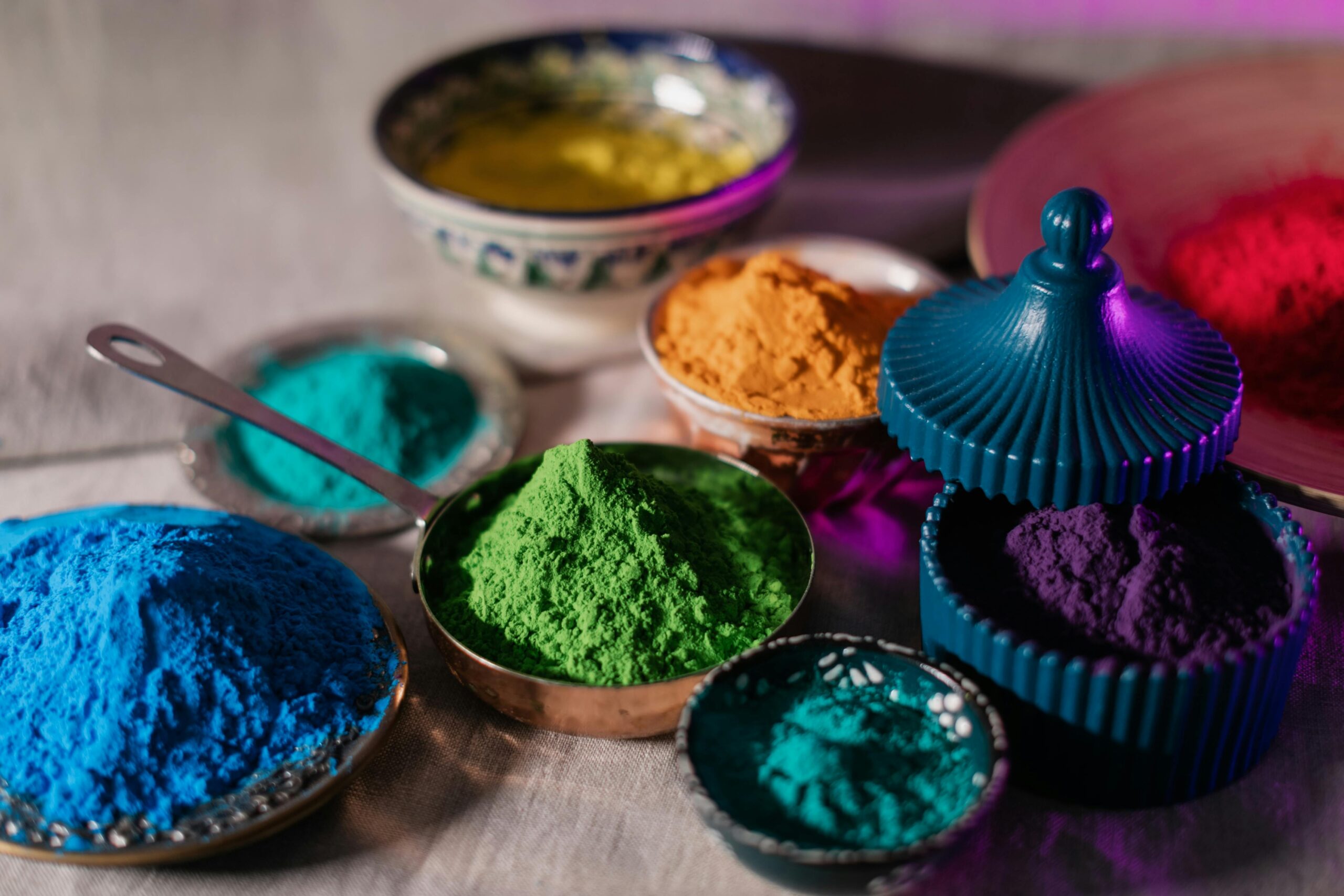A festival that paints the sky with vibrant hues and fills the air with laughter and joy, Holi is a celebration deeply rooted in the cultural tapestry of India. Originating from ancient Hindu mythology, Holi marks the victory of good over evil, the arrival of spring, and the fostering of unity and friendship. As bonfires blaze and colors dance in the streets, Holi transcends barriers of age, religion, and social status, bringing people together in a riot of exuberance and merriment.
Historical Background of Holi:
Delving into the annals of history, one finds the origins of Holi intertwined with captivating tales of gods and demons. Among the most renowned legends is the story of Prahlad and Holika, illustrating the triumph of devotion and righteousness over malevolence. Another cherished mythological narrative recounts the playful antics of Lord Krishna and Radha, immortalized in the colorful revelry of Vrindavan and Mathura. These stories serve as the bedrock upon which the vibrant tapestry of Holi is woven, infusing the festival with layers of symbolism and significance.
Unveiling the Rainbow: The Symbolism of Colors
Holi is a kaleidoscope of colors, each with its unique meaning. As revelers drench each other in vibrant powders, they’re not just having fun; they’re participating in a symbolic act steeped in tradition.
Here’s a peek into the stories behind some of the most prominent colors:
- Red (Gulal): The most popular color in Holi’s arsenal, red symbolizes love, passion, and fertility. It evokes the playful love story of Krishna and Radha, reminding us of the festival’s connection to affection and new beginnings.
- Green (Pachhwani): This refreshing green represents new life and spring’s arrival. As winter wanes and nature awakens, Holi celebrates the blossoming of the natural world and the hope it brings.
- Blue (Asmani): The calming blue signifies the vastness of the sky and the universal spirit that connects us all. It’s a reminder to approach the festival with a sense of peace and inclusivity, embracing the joy of community.
- Yellow (Pila): The brilliant yellow of sunshine symbolizes positivity, knowledge, and happiness. It reflects the festive spirit of Holi, a time to shed inhibitions, embrace laughter, and celebrate life’s simple pleasures.
The Stories Woven into Holi

The vibrant colors of Holi are more than just visual spectacles; they’re threads woven into the rich tapestry of the festival’s legends. Two prominent stories add depth and meaning to the celebrations:
The Triumph of Good: Holika and Prahlad

One popular legend tells the tale of King Hiranyakashyap, an arrogant ruler who demanded worship from his subjects. His son, Prahlad, defied him, choosing to devote himself to Lord Vishnu. Enraged, the king hatched several plans to kill Prahlad, but each attempt was thwarted by divine intervention. Finally, the king’s sister, Holika, tricked Prahlad into entering a pyre with her. However, Prahlad’s unwavering faith in Vishnu protected him, while Holika, consumed by her pride, perished in the flames. Holi celebrates this victory of good over evil, with the bonfire on the eve of Holi (Holika Dahan) symbolizing the burning away of negativity.
Love’s Playful Dance: Krishna and Radha

Another enchanting story associated with Holi revolves around Lord Krishna and his beloved Radha. In this playful tale, Krishna, with his dark complexion, playfully smeared colors on Radha’s fair skin to bridge the gap between them. This act of love and acceptance is reflected in the throwing of colors during Holi, reminding us to break down social barriers and celebrate the beauty of diversity.
Holi for All: A Celebration that Transforms Boundaries
Holi’s magic extends far beyond the borders of India. Celebrated by Hindus worldwide, the festival has also transcended religious boundaries, becoming a global phenomenon. From London’s Holi celebrations in Trafalgar Square to vibrant festivities in the Caribbean and North America, Holi’s spirit of joy and inclusivity resonates across cultures.
A Feast for the Senses: The Sounds and Flavors of Holi
Holi is a multi-sensory experience that engages all the senses. The vibrant visuals are complemented by the lively music and energetic dances that erupt during celebrations. Traditional folk songs like “Holi Hai” fill the air, while energetic Bhangra and Dandiya Raas dances create a joyous atmosphere.
No celebration is complete without a delightful feast. Holi is traditionally associated with sweet and savory treats like Gujiya, deep-fried pastries filled with a sweet or savory filling, and Thandai, a refreshing coolant made with milk, nuts, seeds, and spices. These culinary delights tantalize the taste buds and add another layer of cultural richness to the festival.
Celebrating Sustainably: Eco-Friendly Holi Practices
While throwing colored powder is a central part of Holi, there’s a growing concern about the environmental impact of synthetic colors. These non-biodegradable powders can pollute waterways and harm wildlife. Thankfully, there’s a move towards a more sustainable Holi.
Here are some eco-friendly practices you can adopt:
- Embrace Natural Colors: Ditch the chemical-laden powders and embrace the beauty of natural dyes. Use ingredients like turmeric, beetroot powder, and flower petals to create vibrant and eco-friendly colors.
- Play Responsibly: Be mindful of who you throw colors at. While enthusiastic participation is encouraged, respect others’ boundaries and avoid targeting people who might not want to be involved.
- Clean Up After Yourself: Don’t let the vibrant colors stain the streets and parks. Carry a small bag to collect used colors and dispose of them responsibly.
The Lasting Significance of Holi
Holi is more than just a day of joyous abandon. It’s a time for reflection, renewal, and strengthening bonds. Here are some ways to embrace the deeper meaning of the festival:
- Forgive and Forget: This is a time to let go of past grievances and embrace forgiveness. Use this opportunity to mend relationships and start fresh.
- Spread Kindness: The spirit of Holi encourages inclusivity and acceptance. Share the joy of the festival with others, especially those who might be feeling lonely or isolated.
- Embrace New Beginnings: As spring arrives and nature awakens, it serves as a reminder to embrace new beginnings. Let go of negativity and outdated habits, and step into a brighter future with renewed optimism.
Celebrating Holi in Your Community:
Looking to experience the magic of Holi firsthand? Here are some ways to get involved:
- Connect with Local Hindu Communities: Many Hindu communities organize public Holi celebrations with traditional music, dance, and of course, the throwing of colors! Reach out to local cultural centers or temples to learn about their celebrations.
- Participate in Public Events: Many cities host Holi festivals open to the public. These events offer a chance to experience the vibrant energy of Holi, learn about its cultural significance, and celebrate with people from all walks of life.
- Host Your Gathering: Gather your friends and family for a mini-celebration! Make natural colors together, prepare traditional & healthy snacks, play Indian music, and enjoy the joy of throwing colors in a safe and controlled environment.
DIY recipes for natural Holi colors:
Making your natural colors is a fun and eco-friendly way to celebrate. Here are detailed recipes for some vibrant and safe colors using ingredients you might already have:
- Yellow:
- Sunshine Yellow: Mix 2 teaspoons of turmeric powder with 4 teaspoons of gram flour (chickpea flour). Rub the mixture between your palms to ensure an even distribution of color.
- Red:
- Cherry Red: This recipe uses red sandalwood powder, which might be less common but offers a beautiful red color. If unavailable, try the beetroot option below. Mix red sandalwood powder with water to get a consistent red solution.
- Beetroot Red: Boil a few beetroot slices in water. Once softened, mash the beetroot and strain the colored water. You can adjust the concentration for a deeper red.
- Pink:
- Rose Petal Pink: Sun-dry rose petals until crisp. Grind them into a fine powder. You can mix this with some gram flour for better consistency.
- Beetroot Pink: Dilute the beetroot red water (from the recipe above) with water to achieve a lighter pink shade.
- Green:
- Mehendi Magic: While the henna powder is often used for temporary tattoos, it can also create a lovely green color. Use pure henna powder (without any chemical additives) and mix it with an equal amount of gram flour.
- Leafy Greens: If you don’t have henna, you can also use dried and powdered leaves like spinach, coriander, or methi (fenugreek) for a natural green hue.
Tips:
- Base it Up: For all the dry color recipes, use a base of gram flour or cornstarch. This helps the color adhere to the skin and makes it easier to clean up afterward.
- Dry Thoroughly: Make sure all your natural ingredients are completely dry before grinding them into a powder. This prevents spoilage and ensures vibrant colors.
- Safety First: Patch test any color on a small area of your skin before applying it liberally. This is especially important for people with sensitive skin.
- Get Creative: Feel free to experiment with different ingredients! You can use paprika for a light orange, hibiscus flowers for a deep red, or even carrot tops for an earthy green.
By making your natural colors, you’re not only contributing to a safer and more eco-friendly celebration, but you’re also adding a personal touch to the festivities! Have a happy Holi!
Holi Safety Tips for a Colorful Celebration!
This is a vibrant festival filled with joy and vibrant colors. To ensure you have a safe and happy Holi, here are some practical tips:
Protect Your Skin and Eyes:
- Natural is best: Opt for organic, herbal colors made from plant products like turmeric or sandalwood. These are gentler on your skin and the environment.
- Moisturize: Apply a generous layer of coconut or mustard oil on exposed skin a day before Holi. This creates a barrier, making colors easier to remove later.
- Sunscreen: Don’t forget sunscreen! Apply SPF 30 sunscreen to protect your skin from the sun and potential irritation from colors.
- Eye care: Wear sunglasses or goggles to shield your eyes from color powder.
Dress for the Occasion:
- Cover Up: Wear old clothes that you don’t mind getting stained. Opt for long-sleeved shirts and full pants for maximum coverage.
- Protect your feet: Wear comfortable shoes that you can easily wash or discard if necessary.
Celebrate Responsibly:
- Stay hydrated: Drink plenty of water throughout the day to stay cool and prevent dehydration.
- Be mindful of others: Avoid throwing colors at people who aren’t interested in playing.
- Respectful play: Don’t use water balloons filled with harsh chemicals or dirty water.
- Be aware: Stay in familiar areas and celebrate with trusted friends and family.
After the Fun:
- Gentle cleansing: Use lukewarm water and a mild cleanser to remove colors. Avoid harsh scrubbing.
- Deep condition: Use a nourishing hair conditioner to remove color from your hair and restore moisture.
- Moisturize: Apply a calming lotion or aloe vera gel to soothe any skin irritation.
By following these tips, you can ensure a safe and enjoyable Holi celebration filled with vibrant colors and lasting memories!
Embrace the Spirit of Holi: A Celebration of Life
Holi is more than just a riot of colors; it’s a celebration of life, renewal, and the triumph of good over evil. It’s a time to shed inhibitions, reconnect with loved ones, and embrace the joy of community. Whether you participate in local festivities, throw a small gathering with friends, or simply appreciate the vibrant spirit of the day, let this festival remind you of the simple pleasures in life – laughter, love, and the beauty of human connection.
FAQs
What is the significance of Holi?
Holi is a Hindu festival celebrated primarily in India, marking the triumph of good over evil, the arrival of spring, and the fostering of unity and friendship.
What are the origins of Holi?
Holi’s origins are rooted in Hindu mythology, with stories such as the triumph of Prahlad over Holika and the playful antics of Lord Krishna and Radha serving as prominent narratives associated with the festival.
Why is Holi known as the festival of colors?
Holi is known as the festival of colors because of the tradition of drenching each other in vibrant colored powders and water, symbolizing the arrival of spring and the blossoming of new life.
What are the main colors used in Holi, and what do they symbolize?
The main colors used in Holi include red (symbolizing love and fertility), green (representing new life and spring), blue (signifying peace and inclusivity), and yellow (symbolizing positivity and happiness).
How is Holi celebrated globally?
Holi is celebrated not only in India but also across the world, with vibrant festivities taking place in countries with significant Hindu populations and beyond, including the Caribbean, North America, and Europe.
What are some traditional foods associated with Holi?
Traditional foods enjoyed during Holi include Gujiya (deep-fried pastries with sweet or savory fillings) and Thandai (a refreshing drink made with milk, nuts, seeds, and spices).
How can Holi be celebrated in an eco-friendly manner?
Eco-friendly Holi practices involve using natural colors derived from ingredients like turmeric, beetroot, and flower petals, as well as being mindful of waste disposal and respecting environmental concerns.
What are some safety tips for celebrating Holi?
Safety tips for celebrating Holi include protecting the skin and eyes with moisturizers and sunglasses, wearing old clothes, staying hydrated, and being mindful of others’ boundaries during celebrations.
How can individuals participate in Holi festivities in their communities?
Individuals can participate in Holi festivities by connecting with local Hindu communities, attending public events, or hosting their gatherings with friends and family.
What are some DIY recipes for natural Holi colors?
DIY recipes for natural Holi colors include using ingredients like turmeric, beetroot, henna, and dried leaves to create vibrant and eco-friendly colors for celebrations.



